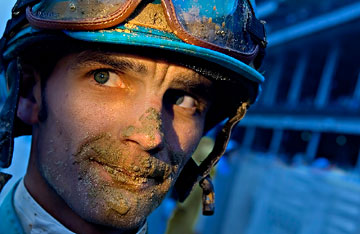 Hi and welcome to this edition of Workshop at the Ranch. If you have read this month’s June issue of On the Road you get a sense of what I look for when covering the day of the Kentucky Derby at Churchill Downs, but, the Derby week offers much more than just Saturday’s race coverage. One of my projects involved portraits of the jockeys. I wanted to do something different by using some off camera lighting on location in the paddock, on the track and around the winner’s circle. Extreme caution must be exercised when using flash around horses. They can easily be spooked by the sudden burst of light, but my experiences with the Nikon SB800 Speedlight system has grown this past year and I felt I could discretely and effectively light up the jockeys without disturbing any million dollar race horses.
Hi and welcome to this edition of Workshop at the Ranch. If you have read this month’s June issue of On the Road you get a sense of what I look for when covering the day of the Kentucky Derby at Churchill Downs, but, the Derby week offers much more than just Saturday’s race coverage. One of my projects involved portraits of the jockeys. I wanted to do something different by using some off camera lighting on location in the paddock, on the track and around the winner’s circle. Extreme caution must be exercised when using flash around horses. They can easily be spooked by the sudden burst of light, but my experiences with the Nikon SB800 Speedlight system has grown this past year and I felt I could discretely and effectively light up the jockeys without disturbing any million dollar race horses.
Hi and welcome to this edition of Workshop at the Ranch. If you have read this month’s June issue of On the Road you get a sense of what I look for when covering the day of the Kentucky Derby at Churchill Downs, but, the Derby week offers much more than just Saturday’s race coverage. One of my projects involved portraits of the jockeys. I wanted to do something different by using some off camera lighting on location in the paddock, on the track and around the winner’s circle. Extreme caution must be exercised when using flash around horses. They can easily be spooked by the sudden burst of light, but my experiences with the Nikon SB800 Speedlight system has grown this past year and I felt I could discretely and effectively light up the jockeys without disturbing any million dollar race horses.
My technical approach would be similar to the images I have been making of NFL players emerging from the locker rooms and running onto the field, the basic formula being underexposing my background scene by about -1 stop and increasing the power output of my SB800 by about +1 stop … give or take a little on exposure and power output depending on how subtle or stylized you want the picture to be … ( see February 2006 WATR article “My Moody Blue Formula” and May 2007 WATR article on “SB800 Location Lighting in Mexico.” ) I also have learned how to use a LumiQuest Snoot on my SB800 to add just a “pinch” of light across my subjects face. It was my intention to use these techniques to simply add some “Light On The Run” ……………………
(Note: My photographic responsibilities on the day of the Kentucky Derby did not involve following the jockeys for portraits. These “Light On the Run” portraits were made during the two days before the Kentucky Derby which included Oaks Day and the running of the Half Million Dollar Kentucky Oaks race. The race week and especially Oaks Day were very overcast with intermittent rain showers. These poor weather conditions helped make a moody environment and great faces.)
|
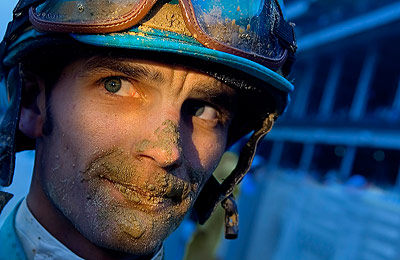 Image #1 Jamie Theroit … The rain soaked Churchill Downs race track provided plenty of mud kicked up by the leaders into this jockey’s face. His race horse is about 10 feet behind him being escorted back to the barn area and is out of visual range of my SB800. I’ve positioned myself a few feet onto the track where Jamie is quickly walking off towards the the weigh scale that is about 8 feet behind me. I held one remote SB800 with Warming Gel in my left hand and positioned it off camera to the left and slightly above the level of the brim of his helmet. I’ve placed a LumiQuest Snoot on the remote SB800 and I have “pinched” the opening of the snoot with a paper clip that allows only a narrow shaft of light to illuminate a portion of his goggles and face. I shot one frame as he passed by me close enough to position the SB800 less than 2 feet from his face. I underexposed the scene by about 1 1/3 stop and increased the power of my SB800 with a power output of +1. I used a cool/blue WB of 3200K and then used the Warming Gel that comes standard with the SB800 Speedlight to counter the cool/blue WB and add a warm skin tone to my subjects face. Nikon D2Xs, ISO200, 1/500 at f4, Nikon 17-55mm Lens, WB 3200K, Nikon SU800 Commander to trigger the remote SB800, Nikon SB800 as a Remote in i-TTL mode with a power output of +1, Lexar 8G Flash Card. This, in general, is the basic formula I like to use …. give or take a little by varying the amount of underexposure with the camera and the increased power output with the SB800. This formula is not absolute but a guideline to help you get started. Each picture in this article makes “general” use of this basic formula with slight “gives and takes” in camera exposure/power output which makes each picture unique. The most difficult task was to place the strobe in a position so the shaft of light would illuminate his eye and a portion of his face and a bit of the goggles while he was briskly walking by me. It was like threading a needle with light but the more jockeys I photographed the better and more comfortable I became with my Light On The Run quest. Image #1 Jamie Theroit … The rain soaked Churchill Downs race track provided plenty of mud kicked up by the leaders into this jockey’s face. His race horse is about 10 feet behind him being escorted back to the barn area and is out of visual range of my SB800. I’ve positioned myself a few feet onto the track where Jamie is quickly walking off towards the the weigh scale that is about 8 feet behind me. I held one remote SB800 with Warming Gel in my left hand and positioned it off camera to the left and slightly above the level of the brim of his helmet. I’ve placed a LumiQuest Snoot on the remote SB800 and I have “pinched” the opening of the snoot with a paper clip that allows only a narrow shaft of light to illuminate a portion of his goggles and face. I shot one frame as he passed by me close enough to position the SB800 less than 2 feet from his face. I underexposed the scene by about 1 1/3 stop and increased the power of my SB800 with a power output of +1. I used a cool/blue WB of 3200K and then used the Warming Gel that comes standard with the SB800 Speedlight to counter the cool/blue WB and add a warm skin tone to my subjects face. Nikon D2Xs, ISO200, 1/500 at f4, Nikon 17-55mm Lens, WB 3200K, Nikon SU800 Commander to trigger the remote SB800, Nikon SB800 as a Remote in i-TTL mode with a power output of +1, Lexar 8G Flash Card. This, in general, is the basic formula I like to use …. give or take a little by varying the amount of underexposure with the camera and the increased power output with the SB800. This formula is not absolute but a guideline to help you get started. Each picture in this article makes “general” use of this basic formula with slight “gives and takes” in camera exposure/power output which makes each picture unique. The most difficult task was to place the strobe in a position so the shaft of light would illuminate his eye and a portion of his face and a bit of the goggles while he was briskly walking by me. It was like threading a needle with light but the more jockeys I photographed the better and more comfortable I became with my Light On The Run quest.
|
 Image #2 Robby Albarado … Albarado would be riding Curlin in the Kentucky Derby and then go on to win the Preakness, the second leg of the Triple Crown. Here Robby wins a stakes race on Oaks Day and avoids being plastered with mud by leading the race wire to wire. He gives the thumbs up sign while walking from the winner circle track side at Churchill Downs. With his race horse turned towards the barn area I used Two remote SB800 with warming gels rubber banded together on top of one another tandem to form a single hand held package of Speedlights, no snoot was used because I wanted a broader spread of light. The overcast skies really work well when using the cool/blue white balance setting at the lower end of the Kelvin scale. The warming gel counters the cool/blue WB and illuminates my subject with warm light. This time I chose a slow shutter speed of 1/15 of a second with rear curtain sync and simply panned with Robby as he walked by me. The 1/15 shutter speed created a nice motion pan blur while the SB800 flash froze my subject. The tandem SB800s were held by one of my assistants for the Oaks and Derby day, Sierra. Sierra positioned herself across from me as each of the jockey’s would dismount and make there way to the weigh scale or winner circle adjacent to the track. Sierra is a fine young photographer and was a quick understudy who grasped the “Light On The Run” concept immediately. Nikon D2Xs, ISO160, 1/15 at f11 (approx.: 1 1/3 stop underexposed), Nikon 17-55mm Lens, WB 4000K, SU800 Commander, Two Nikon SB800 Speedlights each with a power output of +1.3, Lexar 8G Flash Card. Sierra kept herself about 3-4 feet from each jockey as the walked between us. She and I would sometimes take a side step to keep pace with the jockey so as to keep our light on the run mobile studio with our subject. Image #2 Robby Albarado … Albarado would be riding Curlin in the Kentucky Derby and then go on to win the Preakness, the second leg of the Triple Crown. Here Robby wins a stakes race on Oaks Day and avoids being plastered with mud by leading the race wire to wire. He gives the thumbs up sign while walking from the winner circle track side at Churchill Downs. With his race horse turned towards the barn area I used Two remote SB800 with warming gels rubber banded together on top of one another tandem to form a single hand held package of Speedlights, no snoot was used because I wanted a broader spread of light. The overcast skies really work well when using the cool/blue white balance setting at the lower end of the Kelvin scale. The warming gel counters the cool/blue WB and illuminates my subject with warm light. This time I chose a slow shutter speed of 1/15 of a second with rear curtain sync and simply panned with Robby as he walked by me. The 1/15 shutter speed created a nice motion pan blur while the SB800 flash froze my subject. The tandem SB800s were held by one of my assistants for the Oaks and Derby day, Sierra. Sierra positioned herself across from me as each of the jockey’s would dismount and make there way to the weigh scale or winner circle adjacent to the track. Sierra is a fine young photographer and was a quick understudy who grasped the “Light On The Run” concept immediately. Nikon D2Xs, ISO160, 1/15 at f11 (approx.: 1 1/3 stop underexposed), Nikon 17-55mm Lens, WB 4000K, SU800 Commander, Two Nikon SB800 Speedlights each with a power output of +1.3, Lexar 8G Flash Card. Sierra kept herself about 3-4 feet from each jockey as the walked between us. She and I would sometimes take a side step to keep pace with the jockey so as to keep our light on the run mobile studio with our subject.
|
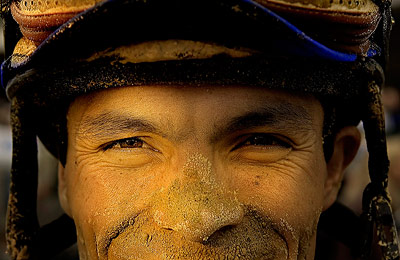 Image #3 Jesus Castanon … Jockeys are more likely to stop and pose for a photographer after a win. Castanon came from behind to win this pre Oaks race. The rain soaked track again produced terrific mud packed faces. The winning race horse is being lead out of the winner circle and Jesus is on his way to a TV interview when I politely asked him for one picture to which he was kind enough to stop for about 1 second and then continue on his way. Sometimes all you get is 1 second so make it count. I held one remote SB800 with warming gel and “pinched” snoot in my left hand so that a narrow shaft of warm light would accent his muddy face. Nikon D2Xs, ISO250, 1/200 at f4 (approx.: 1 2/3 stop underexposed), Nikon 17-55mm Lens, WB 5000K, SU800 Commander, One remote SB800 with warming gel and LumiQuest Snoot “pinched” with a power output of +1.3, Lexar 8G Flash Card. I used a White Balance of 5000K and the warming gel to warm up the picture more than usual. Athletes are so accustomed to a TV camera pressed into their face that Castanon did not seem concerned that I was only 20 inches from his mud covered nose. Image #3 Jesus Castanon … Jockeys are more likely to stop and pose for a photographer after a win. Castanon came from behind to win this pre Oaks race. The rain soaked track again produced terrific mud packed faces. The winning race horse is being lead out of the winner circle and Jesus is on his way to a TV interview when I politely asked him for one picture to which he was kind enough to stop for about 1 second and then continue on his way. Sometimes all you get is 1 second so make it count. I held one remote SB800 with warming gel and “pinched” snoot in my left hand so that a narrow shaft of warm light would accent his muddy face. Nikon D2Xs, ISO250, 1/200 at f4 (approx.: 1 2/3 stop underexposed), Nikon 17-55mm Lens, WB 5000K, SU800 Commander, One remote SB800 with warming gel and LumiQuest Snoot “pinched” with a power output of +1.3, Lexar 8G Flash Card. I used a White Balance of 5000K and the warming gel to warm up the picture more than usual. Athletes are so accustomed to a TV camera pressed into their face that Castanon did not seem concerned that I was only 20 inches from his mud covered nose. |
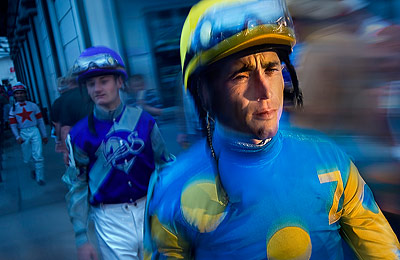 Image #4 Garrett Gomez … Winner of this years Kentucky Oaks is on his way from the jockeys locker room to the Paddock area. My assistant, Sierra, is positioned across from me holding the tandem remote SB800s with warming gels. She is about 5 feet from Garrett. When I use two SB800 Speedlights working in i-TTL mode I don’t get twice the power but I do get half the recycle time which allowed me to photograph each of the fast approaching jockeys with fully charged Speedlights. Nikon D2Xs, ISO100, 1/13 at f16 (approx: 1 1/3 stop underexposed), Nikon 17-55mm Lens, WB 3600K, Nikon SU800 Commander, Two remote Nikon SB800 Speedlights banded together tandem with warming gels power output +1, Lexar 8G Flash Card. This image is similar to the Image of Robby Albarado in that it makes use of a slow shutter speed to create a pan blur and then rear curtain sync with flash to freeze areas of my subject that are illuminated with the Speedlight. The cool/blue scene, warm light and panned motion make for a very stylized picture of winning jockey Garrett Gomez. Image #4 Garrett Gomez … Winner of this years Kentucky Oaks is on his way from the jockeys locker room to the Paddock area. My assistant, Sierra, is positioned across from me holding the tandem remote SB800s with warming gels. She is about 5 feet from Garrett. When I use two SB800 Speedlights working in i-TTL mode I don’t get twice the power but I do get half the recycle time which allowed me to photograph each of the fast approaching jockeys with fully charged Speedlights. Nikon D2Xs, ISO100, 1/13 at f16 (approx: 1 1/3 stop underexposed), Nikon 17-55mm Lens, WB 3600K, Nikon SU800 Commander, Two remote Nikon SB800 Speedlights banded together tandem with warming gels power output +1, Lexar 8G Flash Card. This image is similar to the Image of Robby Albarado in that it makes use of a slow shutter speed to create a pan blur and then rear curtain sync with flash to freeze areas of my subject that are illuminated with the Speedlight. The cool/blue scene, warm light and panned motion make for a very stylized picture of winning jockey Garrett Gomez. |
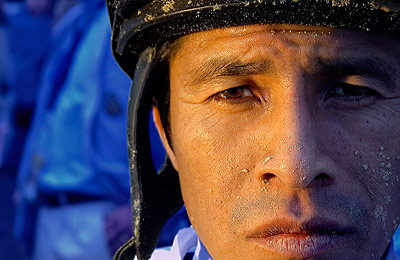 Image #5 Edgar Prado … Image #5 Edgar Prado … Last year’s Kentucky Derby winner aboard Barbaro, Edgar is a primary figure in the horseracing industry and someone who makes a strong portrait. He won a late day stakes race and so I made use of the winner circle again and asked Edgar for one picture before moving on to the TV interview area. One second was all I was given and all that was required to make a stylized portrait of a great champion. Nikon D2Xs, ISO100, 1/250 at f4 (approx: 1 2/3 stop underexposed), Nikon 17-55mm Lens, WB 3200K, Nikon SU800 Commander, Two Nikon remote SB800 Speedlights with warming gels and banded together in tandem with a power output of + 1.3 held by Sierra about 3 feet away, Lexar 8G Flash Card. The late day overcast sky really enhance the cool/blue 3200K WB while the warming gel illuminates Edgar with warm light.
|
Well, I hope you all have enjoyed this Light On The Run style of portraiture. A lot can be done with a little light in a short period of time. I really enjoyed making these pictures. Something new for the magazine. I’m always very cautious and careful when working around race horses. Positioning the Speedlights in close proximity to my subject and using the flash only after the horse is turned away or out of range gave me confidence to pursue something new and unique at the race track. For me, the confidence to use lighting in the manner that I have just discussed came from many hours of practice at smaller sports situations before applying these techniques at a championship event. I wanted to make certain that my use of flash would be acceptable and not an intrusion. Practice ahead of time will always pay off and most likely keep a photographer from over stepping their boundary or causing an uncomfortable situation for athletes, fans and even horses.
I’ll see you next time here on Workshop at the Ranch …………….. Adios, Dave
![]() Hi and welcome to this edition of Workshop at the Ranch. If you have read this month’s June issue of On the Road you get a sense of what I look for when covering the day of the Kentucky Derby at Churchill Downs, but, the Derby week offers much more than just Saturday’s race coverage. One of my projects involved portraits of the jockeys. I wanted to do something different by using some off camera lighting on location in the paddock, on the track and around the winner’s circle. Extreme caution must be exercised when using flash around horses. They can easily be spooked by the sudden burst of light, but my experiences with the Nikon SB800 Speedlight system has grown this past year and I felt I could discretely and effectively light up the jockeys without disturbing any million dollar race horses.
Hi and welcome to this edition of Workshop at the Ranch. If you have read this month’s June issue of On the Road you get a sense of what I look for when covering the day of the Kentucky Derby at Churchill Downs, but, the Derby week offers much more than just Saturday’s race coverage. One of my projects involved portraits of the jockeys. I wanted to do something different by using some off camera lighting on location in the paddock, on the track and around the winner’s circle. Extreme caution must be exercised when using flash around horses. They can easily be spooked by the sudden burst of light, but my experiences with the Nikon SB800 Speedlight system has grown this past year and I felt I could discretely and effectively light up the jockeys without disturbing any million dollar race horses. 






